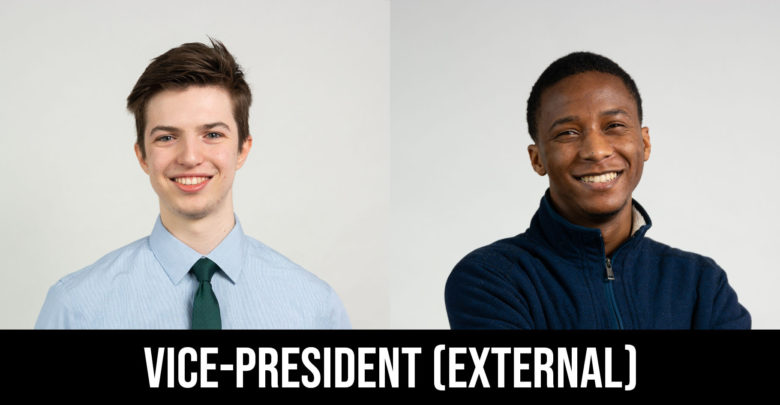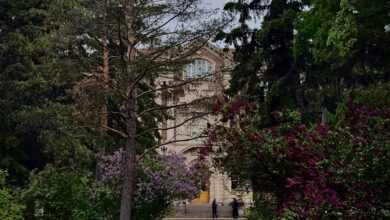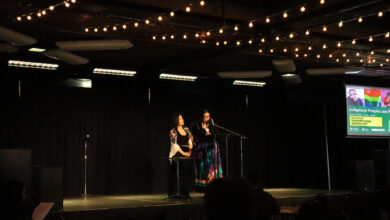SU Elections 2022 Q&A: Vice-President (External)
There are two candidates in the 2022 Students' Union vice-president (external) race, Christian Fotang and Chris Beasley.
 Lochlann Kerr
Lochlann KerrThe Students’ Union vice-president (external) represents the undergraduate student body to the outside community. Focusing on external advocacy, they work with the municipal, provincial, and federal governments on issues that impact students, as well as working closely with post-secondary lobby groups, including the Council of Alberta University Students (CAUS) and the Canadian Alliance of Student Associations (CASA).
There are two candidates in the 2022 Students’ Union vice-president (external) race:
- Chris Beasley, a fifth-year political science student and current Students’ Union arts councillor.
- Christian Fotang, a fourth-year biology student and current Students’ Union vice-president (external).
The following interviews have been edited for brevity and clarity.
In one minute or less, can you tell us why you are running for the position of Students’ Union vice-president (external)?
Beasley: My passion for student governance started a long time ago. I joined Organization for Arts Students and Interdisciplinary Studies (OASIS) in 2018, as a councillor, since then I was a councillor for the Students’ Union for two terms, and I was the president of OASIS as well in the 2020-2021 academic year. I say these, not to say that these are positions that I’ve held or titles that I’ve held, but that this is a passion for doing things for students that I care about a lot. I wouldn’t have done all those things if I didn’t meaningfully want to wake up every day and make the community around me better.
Particularly when it comes to the vice-president (external) position, I spent three years now talking to [the] vice-president (external) and to the president about how we need more direct action and better protests. We need to be pushing the government harder for things that I’ve watched hurt the arts community in the student community overall. Now it’s time basically, for me to run to do those things and to make those things become the case because I know that students need more affordable education, they need more affordable degrees, they need better supports from the provincial and federal government, and there are so many changes that we need to make.
Fotang: This year, I’ve had the opportunity and honour and privilege to serve students in this role. I’ve advocated to them at every level of government: federal, provincial, and municipal. In that time, I’ve been a strong, effective, and dedicated leader. I’ve been chair of the Edmonton Student Alliance and through that I’ve developed great relationships with councillors, and other stakeholders in our city to push for the interests of students. At the federal level, I’ve kept on pushing for the things that students care about. And at the provincial level, we’ve been trying to fight back against cuts to our institutions as well as trying to improve our financial aid system, and I want to continue doing that work.
Can you briefly and concisely describe your platform?
Beasley: The first key tenant of my platform is affordability. It’s not just how much you pay in tuition, but it’s also everything else that goes into what it means to be a student. I want to stop the ongoing tuition increases, with aggressive direct action and fighting for students. I want to ensure that there are more non-repayable grants so that students who graduate don’t have to take on big debt loads. On top of that, I also want to increase affordability by advocating to the city to be able to change bylaws that would allow for more modest to high density housing around the university to naturally depress or stop rent prices from going up.
For community safety, we need funding for sexual violence prevention; the province announced $2.5 million to survey on sexual violence and to release a minimum framework that’s already been sent out to the Board of Governor chairs. But understand that a survey that will take a year or more to complete is not the same as solving the ongoing problem that we have right now. We know that we have a long-term problem that requires long term solutions, we don’t need more information on it. Mental health funding and the ability to be able to fund students in their access of mental health supports is again, a long-term solution for a long-term problem that’s only getting worse, and also increases the affordability of students by not making them have to turn to the private market for their mental health care.
There is a provincial election that’s coming up. We need to run an incredible Get Out the Vote initiative that’s larger than anything we’ve done before. Certainly, something that’s much better than what we had for the most recent municipal and federal elections, and something that’s more evocative of the federal election before last. My pledge in my platform is to collect 5,000 pledges to vote from students. We planned one protest this year, we need to do more demonstrations next year, be they protests, media events, etc. And we need to focus on timing them better.
Fotang: In a concise manner, my platform is about continuing to advocate for increases to financial supports, continuing to advocate for improvements or increases to awareness of job opportunities, and continue to advocate for a healthy and safe community on and off campus.
Alberta’s 2022 Budget was just revealed in the past week — what were your initial reactions, and how would this shape your advocacy?
Beasley: Initial reactions were mixed. A $53 million cut to the university’s Campus Alberta Grant — that’s really bad for students. The province is trying to move us towards reliance on tuition revenue for funding universities as opposed to provincial revenue, moving towards a model that British Columbia and Ontario have. Two responses to that — [first] bad idea. [Second], even if we were to move towards that model, it took decades for those universities in those jurisdictions to move towards that model.
Cutting us another $50 million while we’re still reeling from the $170 million worth of cuts that we’ve already absorbed is insane. We have trimmed back everything we can. Our university is staffed by people who are overworked, undertrained, and doing too much, and we don’t have the ability to absorb this cut.
Other reactions include some notes of hope and support. I’m glad that a lot of funding is headed towards employment opportunities. We need to be pushing for them to go to the right employment opportunities and a diverse set of employment opportunities because not everybody wants to work on a pipeline, and some people do, and that funding will always exist for them.
Fotang: My initial reactions were that there was some good but a lot of bad, especially for U of A students. $54 million in cuts, again, that the U of A has had to bear the brunt of means that I feel like this government is targeting the U of A, and we do need to continue to fight back against that. While we’re happy to see $50 million in grants and bursaries for low-income students in qualified high-demand programs, it still needs to have a larger pool of students supported.
This year, the Alberta full time student grants ran out. And you would think that the government’s decision would be to add more student grants and student bursaries and grant aid. But instead, what they’ve done is just determined what they believe is in high-demand. There’s some good in there but there’s a lot of bad we want to keep fighting against.
Editor’s Note: Under Budget 2022, the U of A received a funding reduction of $52 million. Neither candidate provided the correct number for funding cuts during their interviews — in the interest of transparency, The Gateway left the answers of both candidates intact but chose to include this note on the article noting the error.
While advocating on the behalf of students, it’s important to keep them in the loop. How do you plan to communicate your advocacy to the student body?
Beasley: One of the big things that I’ve always been pushing is grassroots advocacy. The reason why the Students Not Silent protests of two or three years ago now weren’t as successful as they could have been because they were top down. They were planned by a Students’ Union president and vice-president (external). They went with posters and students were asked to show up and then go home. The direction to approach this is that any kind of demonstration, or conversation or action that you’re pulling students into is not a one-time event, but it is an ongoing conversation and discussion with students.
We need to be doing two things in order to engage with students. The first one is involving students in the active recruit train cycle that works for any kind of social movement. You do an action, like the protests that just happened last week, you then recruit more, and I think President [Rowan] Ley did an okay job of this saying at the end of the protest that this is only the first step, that we should continue more. But you need to be actually circulating pamphlets and circulating signup sheets and drawing people on as volunteers and in the loop for future events and demonstrations. And then you train those people up through demonstrations and through resources and giving them access to things and tools and then you act again.
Then, the other answer is that we need to be talking more with faculty associations. What we need to be doing is working with faculty associations holistically throughout the year to be able to judge and deem where their interests lie, what they’re willing to commit, and to be able to build that kind of loyalty and protest culture and resilience that we can then use to be able to have effective direct action.
Fotang: The first thing for that is to make students aware of what this position is. I always sometimes feel that students think that the vice-president (external) has to only have that protest planning role to it, but a lot of it is still lobbying, and there’ll be a lot of behind-the-scenes work, but to communicate that you have to communicate the tangibles to students. So, I’d say at the start of the year, making town halls with execs, where we introduce ourselves to students and introduce our roles and make students really understand what it is that we’re doing, but also learn from them and their issues so that we’re proactive with our advocacy.
A common critique of past external advocacy has been a lack of direct action, including protests, sit ins, and mobilizations of the student body. How do you hope to address this?
Beasley: I’ve been every single direct action and protest that’s happened while I’ve been here at the U of A, that means two students-not-silent up protests, one of which was a partial success, and one of which was a failure. That means that I was out building penguins for the penguin protest in the freezing frigid cold. That means that I was out last week as well. I was also part of the planning committee for the original Students Not Silent protest when the provincial government first came in and was first cutting [funding]. There are great media opportunities to get in front of the camera and to put pressure on the provincial government.
We just need to run demonstrations that target the media. My take is we have a lot of unique resources that only we have because we’re a student’s association. Not only do we have access to for instance, material design students and engineer students so that we could potentially create an art gallery or an art installation on why the cuts hurt the province of Alberta — you know, make a statue out of ramen noodles, etc. We can run these kinds of media events in which we pull in a lot of people and pull in a lot of coverage and try to go viral and use some of the kind of modern techniques that we know work really well.
The final thing that I’ll say is that we need more collaboration between groups. We need to be reaching out and having that broad base of support to be able to talk to those kinds of organizations and just getting bodies out who care about post-secondary, because this isn’t just a student issue, and we need to be able to pack the legislature grounds.
Fotang: This year, we had a really strong direct action through the blue-ribbon protest. I wasn’t able to be there, sadly, but I played a key role in the organization of that protest. We want to continue to build on this.
Around early semester, you know, we’d hope that we could have had some direct action, but we have to be realistic about the limitations of COVID-19 on our ability to organize a protest. Around that time, our provincial health-care system was near collapse, and people had strong legitimate concerns about COVID-19.
[What] I value and really respect about the former vice-president (external) [Rowan Ley] is what he did on the penguin protest. Penguins, I believe now, weren’t enough to cut through the noise in the walls of the legislature about what students were facing. We needed that direct student involvement. We needed that allyship between students, professors, academic staff, non-academic staff, and we’ve done that [with] the blue-ribbon demonstrations and we’re going to continue to build on that movement.A Students’ Union survey revealed that 33 per cent of U of A students want to leave Alberta after graduating, 51 per cent of students are facing food insecurity, and 54 per cent of LGBTQIA+ students want to leave after graduating. Commonly referred to as a ‘brain drain,’ this issue is on many students’ minds. What steps will you take to address this?
Beasley: To all the students that feel that way I understand. I’m a queer student, and the policy and the messaging from this government has not aligned with what I know Alberta can be.
I want to break this down into two aspects. I want to talk about the Government of Alberta’s employment opportunities and then the Government of Alberta’s policies and how they both need to enact and basically make it so that students are being told that this is a safe and supportive environment that they can stay in and be in. Employment opportunities are huge, not only because they passively contribute to affordability, which then reduces impacts on food insecurity. I was a volunteer with the Campus Food Bank for over two years, and I watched as the rates of people accessing those services only increased under these cuts from the government as affordability went down.
Being able to have co-ops and internships allows you to pull an income making your degree more affordable. When the co-op internships happen, oftentimes the result of that is that students are able to secure full time jobs post-graduation with those firms or with those organizations, which means that they’re more likely to stay in Alberta, and like avoid that brain drain because they’ve already got community connections that tie them here. We need to be targeting the provincial government to up for instance like sexual violence prevention programming, mental health resources, etc.
Fotang: I’ve been working with city councillors to see ways that we can improve and make our city attractive and competitive to recruit the businesses and the job opportunities that will let students stay here. But also, we have to talk about safety, affordable housing options, and safety on transit, as well as employment; these are the things that attract talent. These are the things that retain talent.
This is what I’ve worked with City Council on and continue to work with City Council on, but I’ve also been reaching out with networks in the Edmonton Chamber of Commerce, Edmonton Global, Edmonton Metropolitan Regional Board, and right after elections, I plan to get back to work and to build these connections and brainstorm those ways that we can continue to make Edmonton that attractive place to stay.
Fun question: The vice-president (external)’s role includes meeting with elected officials to advocate on behalf of students. If you were to have dinner with any politician, dead or alive, who would you choose?
Beasley: I worked as a page for the Alberta legislature, and I learned a lot about the Alberta Social Credit Party and William Aberhart in particular — its founder. I don’t think it would be an enjoyable dinner, but I think it would be fascinating, and I will pick “Bible Bill” William Aberhart.
Fotang: You know, I think the obvious answer at the moment is the President of Ukraine, Volodymyr Zelenskyy. I think he’s been an inspirational figure for his people and a beacon of leadership and strength around the world. I think he’d be an exciting person’s brain to pick about leading through challenging times and leading people through times of adversity — which is I feel something were also feeling here.
-With files from Jin He.




